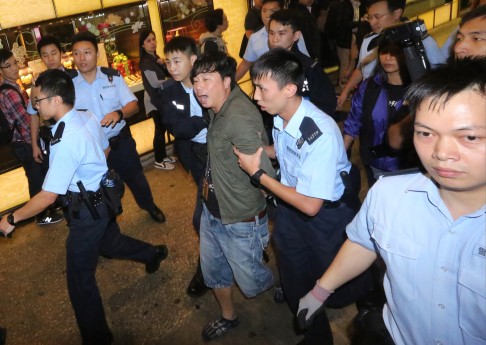
To soldier on, be like water
There is no question that Hong Kong people love to shop; that’s why they call the city a shoppers’ paradise. This past week, citizens took our national sport to a whole new level. Gou wu – which means shopping in Mandarin – has become the battle cry for pro-democracy protesters to call on one another to visit Mongkok in large numbers. The goal is to overrun the area and wear down the police in response to their heavy-handed clearance of the Mongkok protest site a week ago. These shopaholics were hard at work in Kowloon even during Sunday’s violent clashes outside the Government Headquarters on the other side of the harbour. They have also found unlikely allies in the United States, where citizens have been organizing “die-ins” at shopping malls by playing dead on the floor in protest of the fatal police shooting of an unarmed teenager in Ferguson, Missouri.
Mongkok, or MK for short, has always been a colourful and somewhat rough-and-tumble part of the city. It is a cross between Harajuku and the Bronx, where shopping centres tower over decades-old tenement buildings, where young buskers belt out Cantopop oldies next to a 55-year-old hula-hooper, and where triad bosses patrol the neighbourhood to check up on seedy bars, nightclubs and massage parlours. Since tough streets beget tough crowds, you don’t expect MK protesters to take kindly to the government’s declaration of war last week.
And so when CY Leung called on citizens to resume their shopping routine after Nathan Road reopened, protesters self-organised into legions of retail warriors and descended on MK by the hundreds. These “shopping sprees” begin after dinner (to maximise turnout) and continue well past midnight. Shoppers walk in slow motion to clog sidewalks, pretend to drop and pick up loose change to stop traffic, and stand still for hours to watch movie trailers in front of a giant LCD screen. Never mind it’s 2:30 in the morning, shoppers holler “I want to buy a gold watch!” or “Sell me an iPhone 6!” in mocking Mandarin while marching down the busy thoroughfare. It gives new meaning to the expression “shop till you drop.”

The police finds little amusement in the shoppers’ antics. Whether it is the stress, the guilt, the plunging morale, or a combination of all three, their reactions range from mild annoyance to raging violence. Whereas unreasonable search and seizure is common and probably illegal, it is the indiscriminate assault on both protesters and bystanders that has drawn the most public outrage. Stories of citizens being randomly snatched by police and tackled to the ground are followed by allegations of torture and sexual molestation while in custody. Officers are also increasingly turning on the media, arresting a television cameraman because his step-ladder had “touched a policeman” and making up stories about a newspaper photographer trying to seize an officer’s gun.
From rank-and-file officers to the riot police, to the PTU tactical unit and the anti-organised crime bureau, Hong Kong’s Finest are slowly coming undone. In a few isolated cases, those who are supposed to “serve with pride and care” appear to have jumped off the deep end, like the PC who ordered a South Asian pedestrian to “go back to India” and the superintendent caught on camera beating innocent passers-by with his baton. It would be unfair, however, to put all the blame on frontline officers. In the epic power struggle between the government and the governed, it is the people – policemen and protesters – who take the heat and get burned. To use a retail analogy, trying to solve a political problem with law enforcement is like dealing with a customer complaint by calling in store security. It’s a no-win proposition for everyone involved.
The Umbrella Movement has proved to be enduring and ever-changing. In the past two months, it has evolved from a class boycott to a mass protest, to a street occupation and now to this: an all-out urban guerrilla warfare playing out in Mongkok every night. Based loosely on Bruce Lee’s combat philosophy to “be formless and shapeless like water,” the new approach is fluid, spontaneous and unpredictable. Above all, it can be easily replicated anywhere in the city – Central, Causeway Bay, Tsim Sha Tsui and Sham Shui Po – with the help of Facebook and Whatsapp.
This new phase of “mobile occupation” has not only given police the run around, but because the line between pedestrians and protesters is blurred, it has also made it harder for participants to be prosecuted under the city’s public order ordinance banning illegal assemblies. This last point is especially relevant given that the High Court has just issued a new injunction barring protesters from remaining on Harcourt and Connaught Roads, and that the days of the Admiralty protest site are numbered. That means protesters will need to think up inventive ways to keep the movement alive while circumventing the law and court orders. It is said that to rid a garden of dandelions, stepping on them will only send the seeds into the wind and worsen the blight. Our government has done just that.

